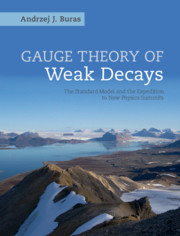Book contents
- Frontmatter
- Dedication
- Contents
- Preface
- Acknowledgments
- List of Abbreviations
- Introduction
- Part I Basics of Gauge Theories
- Part II The Standard Model
- Part III Weak Decays in the Standard Model
- 3 Weak Decays at Tree Level
- 4 Technology beyond Trees
- 5 Short-Distance Structure of Weak Decays
- 6 Effective Hamiltonians for FCNC Processes
- 7 Nonperturbative Methods in Weak Decays
- 8 Particle-Antiparticle Mixing and CP Violation in the Standard Model
- 9 Rare B and K Decays in the Standard Model
- 10 ε′/ε in the Standard Model
- 11 Charm Flavor Physics
- 12 Status of Flavor Physics within the Standard Mode
- Part IV Weak Decays beyond the Standard Model
- Appendix A Dirac Algebra, Spinors, Pauli and Gell-Mann Matrices
- Appendix B Feynman Rules of the Standard Model
- Appendix C Massive Loop Integrals
- Appendix D Numerical Input
- Appendix E Analytic Solutions to SMEFT RG Equations
- References
- Index
12 - Status of Flavor Physics within the Standard Mode
from Part III - Weak Decays in the Standard Model
Published online by Cambridge University Press: 11 June 2020
- Frontmatter
- Dedication
- Contents
- Preface
- Acknowledgments
- List of Abbreviations
- Introduction
- Part I Basics of Gauge Theories
- Part II The Standard Model
- Part III Weak Decays in the Standard Model
- 3 Weak Decays at Tree Level
- 4 Technology beyond Trees
- 5 Short-Distance Structure of Weak Decays
- 6 Effective Hamiltonians for FCNC Processes
- 7 Nonperturbative Methods in Weak Decays
- 8 Particle-Antiparticle Mixing and CP Violation in the Standard Model
- 9 Rare B and K Decays in the Standard Model
- 10 ε′/ε in the Standard Model
- 11 Charm Flavor Physics
- 12 Status of Flavor Physics within the Standard Mode
- Part IV Weak Decays beyond the Standard Model
- Appendix A Dirac Algebra, Spinors, Pauli and Gell-Mann Matrices
- Appendix B Feynman Rules of the Standard Model
- Appendix C Massive Loop Integrals
- Appendix D Numerical Input
- Appendix E Analytic Solutions to SMEFT RG Equations
- References
- Index
Information
- Type
- Chapter
- Information
- Gauge Theory of Weak DecaysThe Standard Model and the Expedition to New Physics Summits, pp. 410 - 414Publisher: Cambridge University PressPrint publication year: 2020
- Creative Commons
- This content is Open Access and distributed under the terms of the Creative Commons Attribution licence CC-BY-NC 4.0 https://creativecommons.org/cclicenses/
